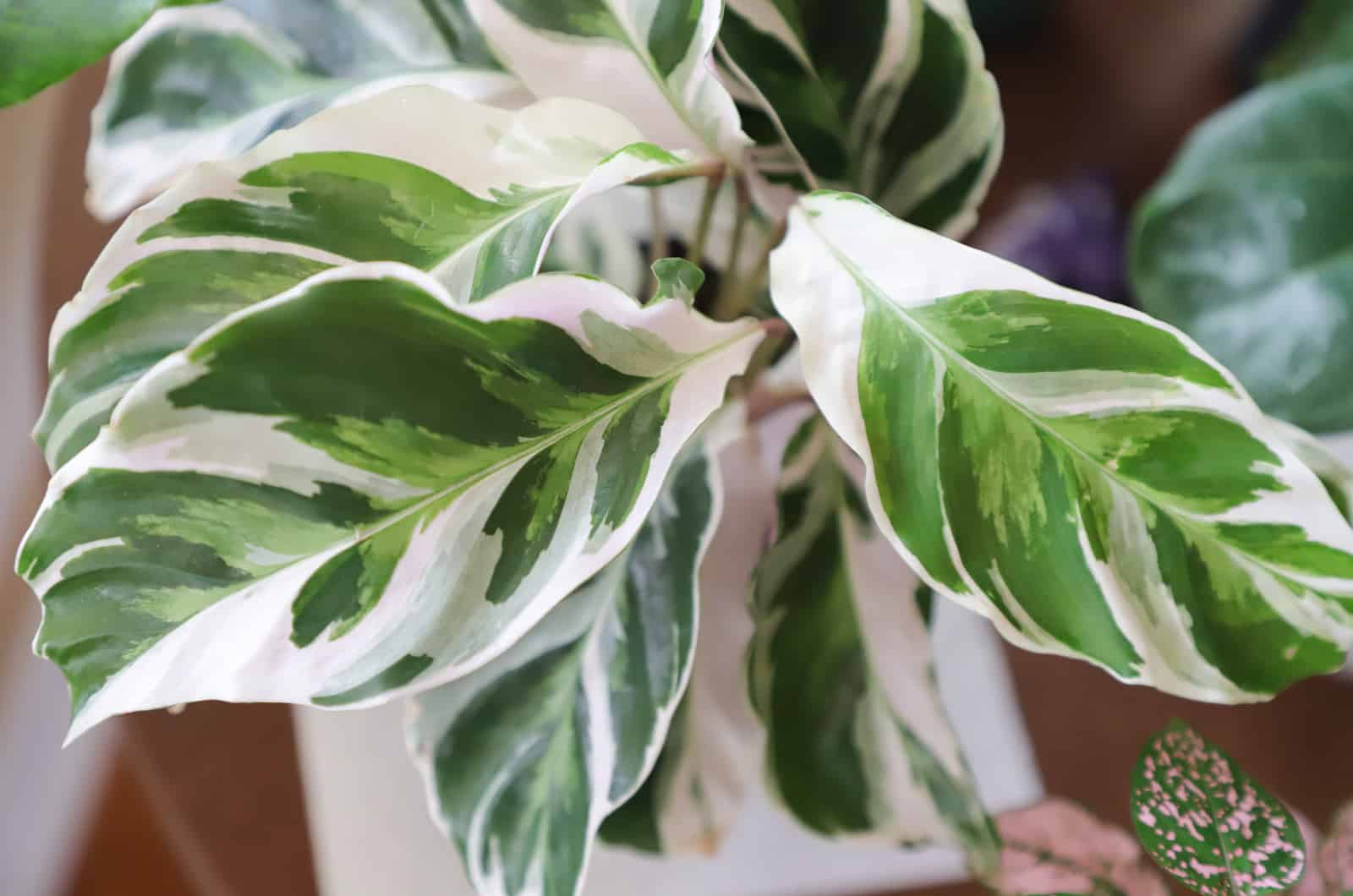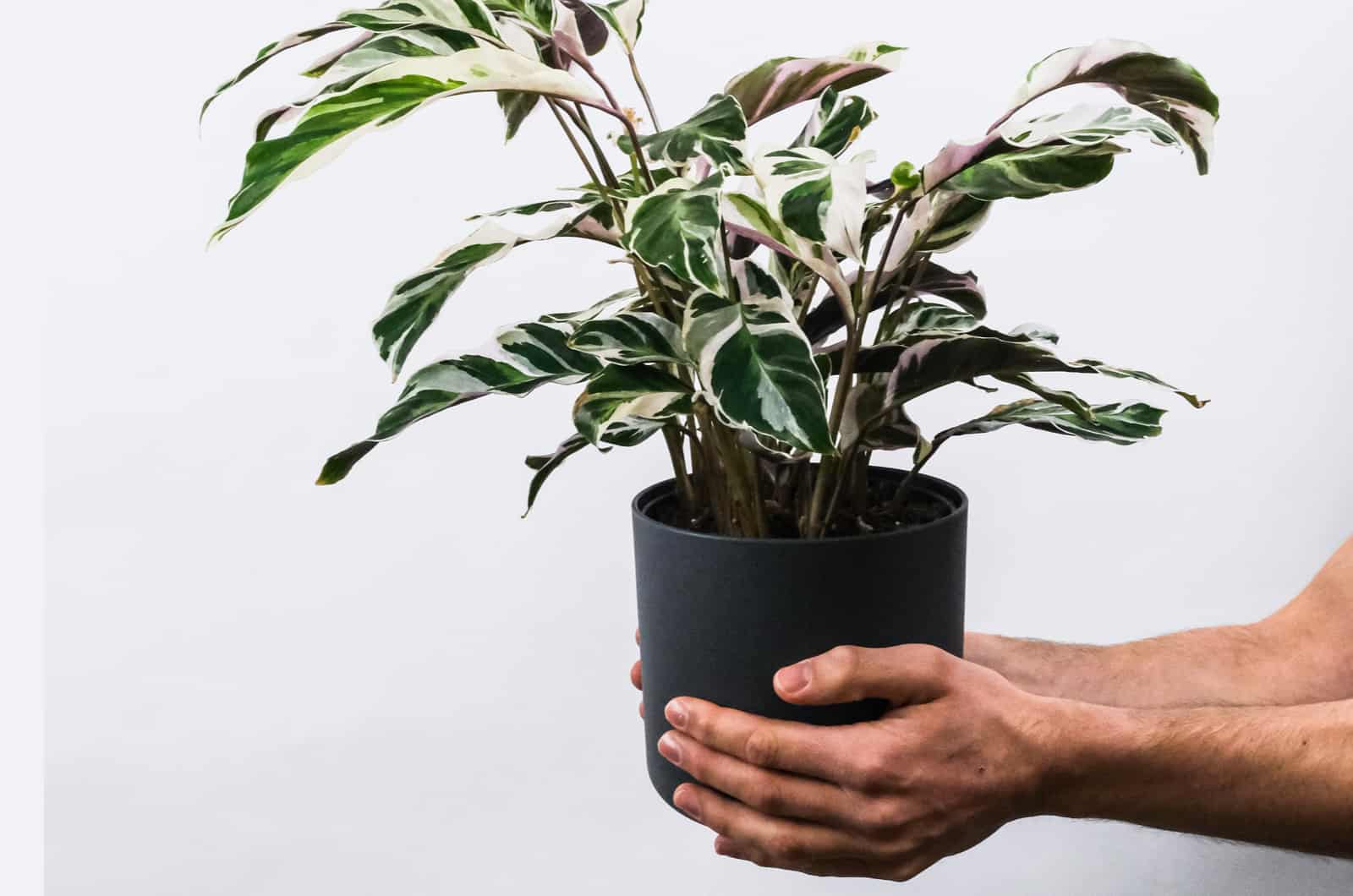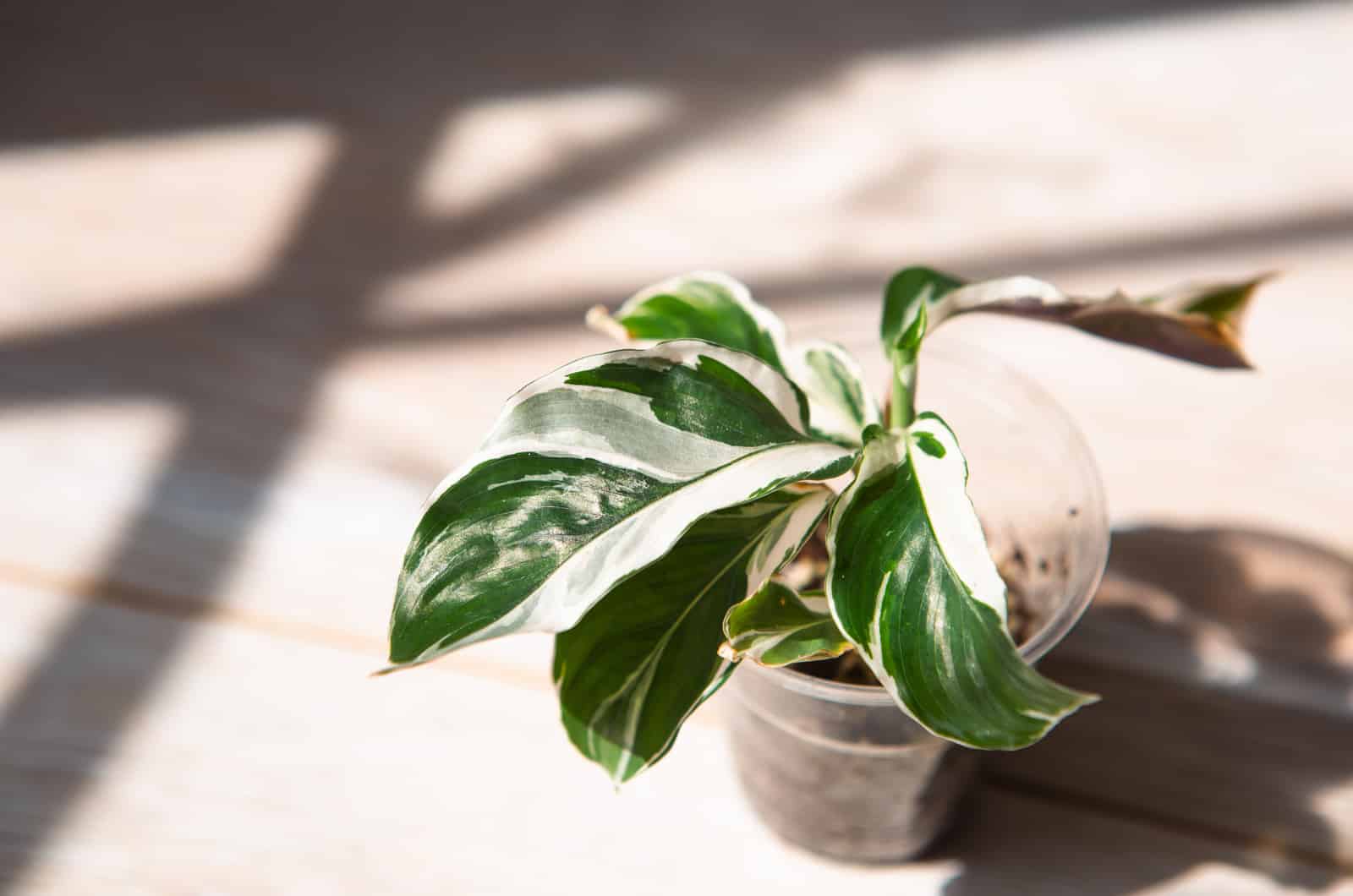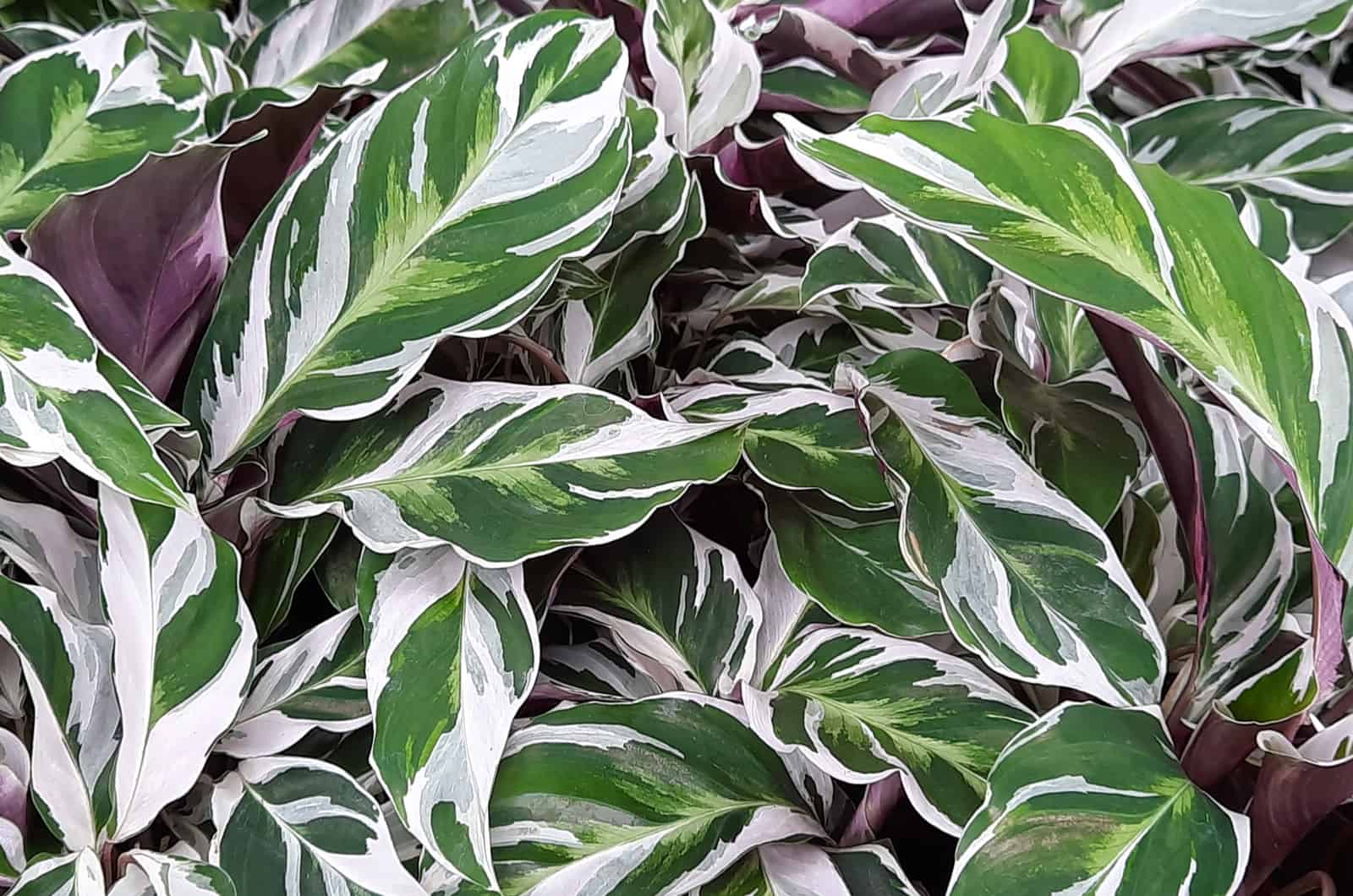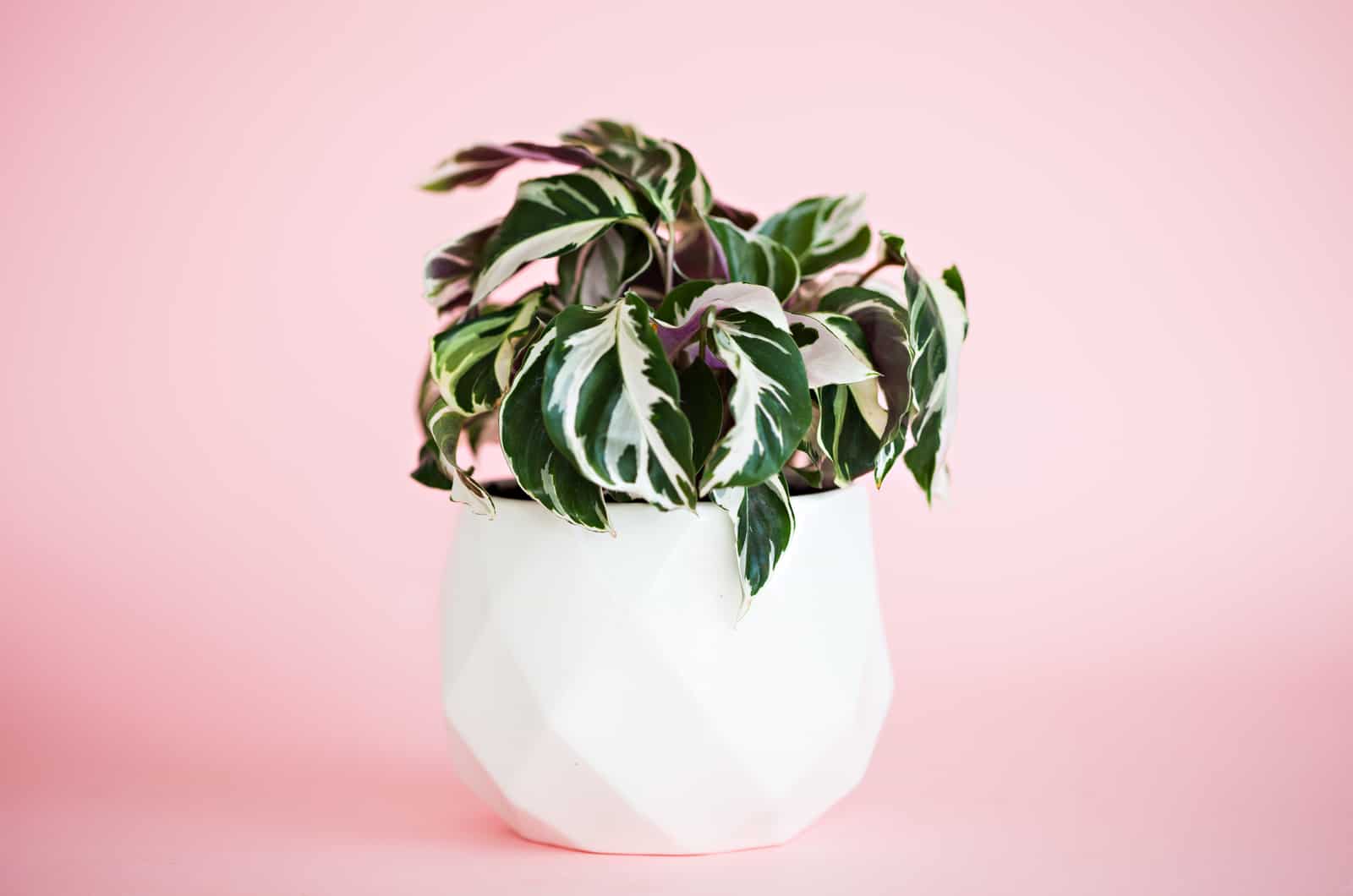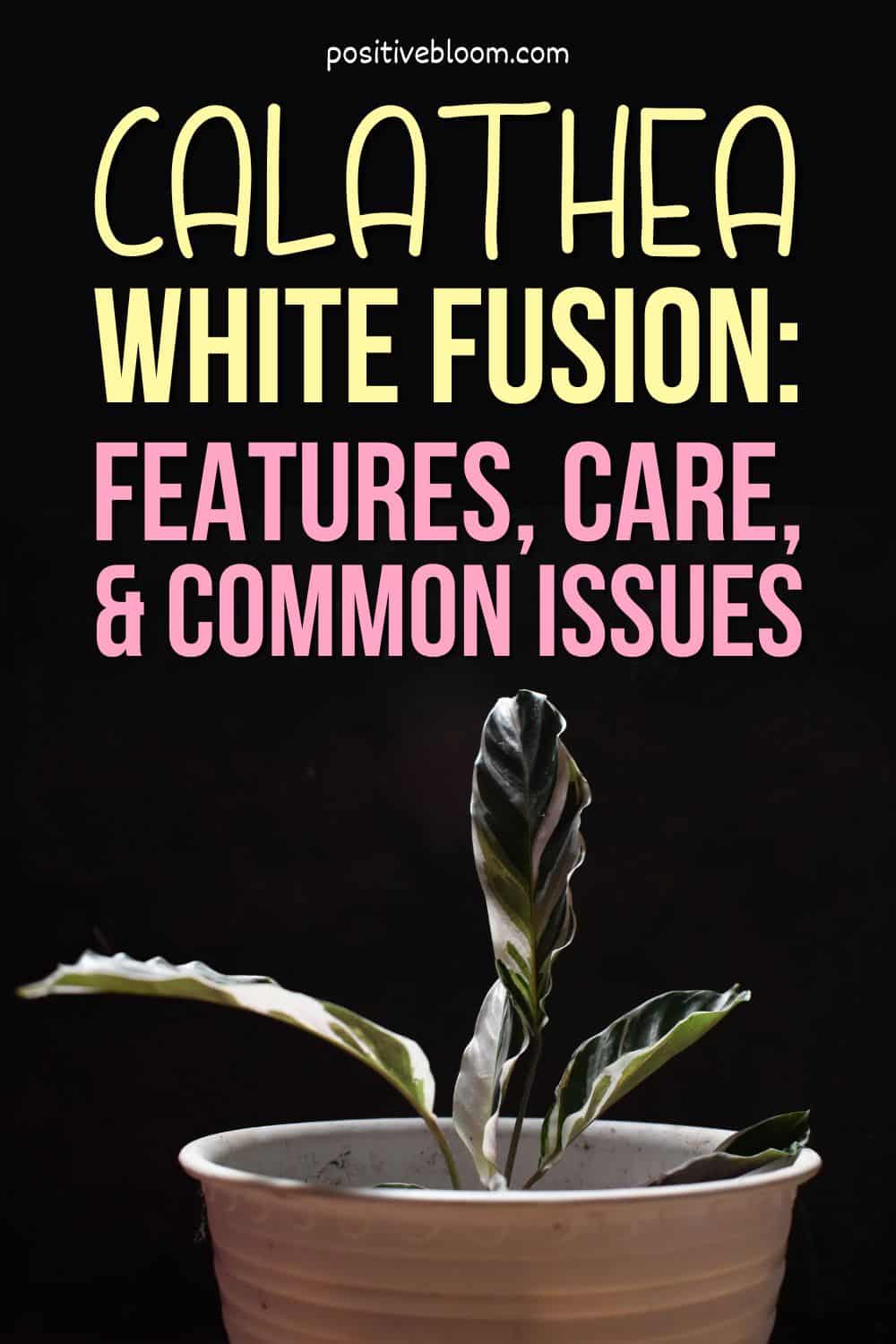If you have been looking for a breathtaking plant, then look no further than the Calathea White Fusion, which is a tropical plant that will make your living room look spectacular!
This Calathea cultivar has variegated leaves and folds up during the night like it’s praying. This houseplant got the name “prayer plant” due to this feature.
However, the White Fusion isn’t a real prayer plant. It folds up like a real prayer plant, but White Fusion belongs to a completely different species. The White Fusion is commonly mistaken with Maranta Leuconeura, which is the real prayer plant.
Plants part of the Maranta genus have a mechanism called “nyctinasty”, which means the leaves fold up and open at sunrise, which is a truly remarkable sight. On the other hand, the White Fusion moves its leaves as the lighting changes. This also looks like praying, but it doesn’t happen because of the circadian rhythm.
This makes the Calathea cultivar a unique plant, as though it may be similar to some other plants, it has many other features that make it stand out.
I can’t wait to tell you everything about the White Fusion, so keep reading as I’m sure you’ll enjoy finding out!
Before we move on, here’s some basic info.
[table id=108 /]What Does The Calathea White Fusion Look Like?
This plant was discovered in 2007 by Taiyan Yam (thank you, sir), which means that it’s relatively new in the world of plants. He propagated it from its parent plant, the Calathea Lietzei.
Its fabulous looks compelled plant growers to get them, and now this plant is on the list of most wanted houseplants.
If the following sections don’t convince you to get yourself a White Fusion of your own, nothing will!
Let’s find out what’s so special about this plant.
Appearance
This plant has a fascinating feature – it can revert. This means that its variegated leaves revert and have an entirely green appearance. I think you’ll agree that this feature is one of the most compelling a plant can have. No wonder everyone wants a White Fusion to be part of their collection!
The Royal Horticultural Society (RHS) claims that pure green plants mutated and created variegated plants.
Another outstanding feature (and the list is long) of White Fusions, is that if the reversion affects the entire plant, you won’t be able to get a variegated plant again by propagation. However, if reversion affects only one part, the new plant will be half green and half variegated. How strange!
Size
The Peacock plant is relatively small compared to most other common indoor plants.
It can grow up to 2 feet in height and about 1 foot in width, which means this Calathea can fit anywhere in your home. However, the ideal place for this plant depends on other conditions.
Leaves
This Calathea plant has dark green leaves with white patterns. The undersides of the leaves have a fascinating magenta shade that extends to the stems.
The great thing is that the leaves grow quickly, so you won’t have to wait long to enjoy the view.
Flowers
The White Fusion produces small flowers in its native habitat. They can be purple, white, or yellow (ideally combined with leaves). However, when grown as an indoor plant there’s a slight chance you’ll see it blooming.
Don’t worry, where there’s a will, there’s a way! You might discover the secret to getting it blooming once you learn how to grow it! Stay tuned for more info.
Growth
The White Fusion has a medium growth rate.
It’s a compact shrub that gets bushy over time, and the lower leaves grow close to each other.
Calathea White Fusion Care Guide
The White Fusion is quite demanding compared to other popular houseplants. It needs sun exposure, however too much sun exposure can damage the plant, as can too little.
The same goes for moisture. It prefers moist soil, but soggy soil can kill it. Dry soil causes problems like wilting. In summary: it doesn’t tolerate more or less of something, so do everything right down the middle and avoid deviations.
Stick to the conditions below to achieve the best results!
Light Requirements
The Calathea White Fusion prefers bright indirect light. It may grow in slightly lower light, but most of us don’t know what slightly lower light really means, and we actually provide it with low light. This is when problems start to occur.
First, your White Fusion could lose variegation when grown in low light, and it could also end up with stunted growth. Luckily, moving the plant into bright indirect light should fix the problem as long as it’s spotted in time.
Too much bright light will bleach the leaves.
You can choose between two options when it comes to placing the plant: a north or east-facing window.
Choose a north-facing window if you live in the US or Canada as it has less light, the same goes for any other Calathea you might grow.
The gentle morning sun that an east-facing window gets will also help your plant thrive.
I suggest avoiding south-facing windows as the plant may receive too much sunlight in the afternoon.
However, if you want to place a White Fusion near a south-facing window for aesthetic purposes, you can use sheer curtains or any other protection that goes well with your home decor.
Temperature Requirements
The ideal temperature for the White Fusion ranges from 60 to 70 degrees Fahrenheit. If you grow other tropical plants (most houseplants are tropical), this Calathea will fit in with them well as it needs the same room temperatures.
I’m most comfortable when the thermostat is set to moderate or warm temperatures. This means that I keep my Calathea prayer plant in the room where I spend the most time.
I have to mention that the White Fusion can’t withstand lower temperatures, so if the temperature drops below 50 degrees Fahrenheit, your plant will struggle to grow.
Lower temperatures may cause stunted growth and foliage discoloration.
Remember to keep the plant away from heat sources and temperature fluctuations, particularly with doors that open and close often.
You can place this plant outdoors, but you must bear in mind that these plants grow best in hardiness zones 11-12b . I suggest you move your White Fusion outdoors if you live in these areas.
You can grow this plant in a pot as a houseplant and move it outdoors during the summer if you live elsewhere. When temperatures start lowering, or before they drop below 60 degrees Fahrenheit, you can bring it back into the house.
Humidity Requirements
South American rainforests have high humidity, so keep this stunning plant in humidity of about 75%.
Moist air = a happy and thriving White Fusion!
I’m sure you’re probably wondering how to increase humidity, as most homes only have moderate humidity. Kitchens and bathrooms have more humidity as warm water evaporates there and increases it.
If your bathroom is dark (like mine), choose the kitchen.
You can increase humidity using any of the following four methods.
Before you increase the humidity, I suggest you use a hygrometer to be sure you really need to.
Misting
Pros: Misting is a simple method that doesn’t take too much time. It only takes a few seconds per leaf. Misting protects the leaves from drying and damage. Moreover, the Peacock plant’s leaves will look glossy after you mist them.
Cons: You need to mist a few times a week. Even though it doesn’t take long, doing it often can be demanding, especially if you’re forgetful. If you skip misting a few times, it will have consequences. Additionally, over-misting (my word for this dangerous act) can result in fungal infection and soft and rotten leaves.
Grouping With Other Plants
Pros: Easy to do: simply place it next to other plants. However, make sure there’s enough space to circulate the air. For example, if you grow any Monsteras, the White Fusion will enjoy their company.
Cons: If you don’t have any other plants or there isn’t enough room.
Pebble Tray
Pros: Once you make it, you don’t need to pay much attention. When you are watering your plant, refill it. It’s available in most plant stores, but many supermarkets sell them too. I prefer the DIY version, which you can make by placing a tray below the pot and adding pebbles. The water evaporates, causing moisture levels to increase.
Cons: If the White Fusion’s roots come into contact with water from a pebble tray, they can suffer from root rot.
Humidifier
Pros: You don’t have to worry about humidity levels if you use a humidifier.
Cons: Humidifiers are pretty expensive. Additionally, they need to be cleaned and checked regularly.
Soil
When it comes to tropical houseplants, there’s one paradoxical thing: they need moist and well-draining soil. The Calathea White Fusion is no exception to this rule.
This makes complete sense. The White Fusion needs a potting mix that retains moisture. However, it also needs a potting mix that doesn’t retain water for too long, as excess water can cause permanent damage.
The plant’s roots need water to uptake the nutrients and send them to other parts of the plant. Dry soil prevents roots from uptaking nutrients, and soggy soil causes root rot.
Balance is the key.
If you want to purchase a potting mix, choose one designed for African violets.
You can also make your own potting mix. First, you need to know which materials fulfill the White Fusion’s soil requirements. I’ll show you how much of each material you need and what combinations are possible.
Here are the materials.
• Commercial potting soil as the base.
• Peat moss and charcoal retain water well.
• Perlite, orchid bark, coco coir, or pumice improve drainage.
Here are the combinations.
• 40% peat moss, 40% perlite, and 20% potting soil.
• 50% potting soil, 20% charcoal, 20% orchid bark, and 10% perlite.
Watering
When it comes to Calathea White Fusion plant care, you’ll spend most of your time and attention on watering.
This plant requires moist soil, but it shouldn’t be soggy. Overwatering causes many problems, like root rot.
On the other hand, light watering or underwatering causes the leaves to curl. The plant might also have a wilting appearance.
There’s one excellent method to check if your White Fusion needs water. Put your finger about 2 inches in the soil, and if it’s dry or almost dry, it’s time for watering.
There’s no strict watering schedule for the prayer plant, as watering depends on many other conditions.
For example, the growing season of White Fusion is in spring and summer, which means it needs more water during this period.
Additionally, warmer temperatures increase the need for watering.
On the other hand, growth slows down during the fall and the plant goes semi-dormant in winter. The Peacock plant needs to be watered less during winter as the soil dries out slower.
How To Water And What Kind Of Water To Use
The White Fusion needs deep watering. Water it gradually and stop watering when the bottom of the soil is moist.
Although this may take time, it’s the easiest way to get rid of excess water and prevent overwatering.
White Fusion is also fussy about the kind of water it gets.
Tap water isn’t a good idea because it may contain chlorine and fluoride. A higher concentration of these chemical elements can cause the Calathea White Fusion’s leaves to become crispy. If you do use tap water, then leave it overnight to sit so the chemicals can evaporate.
You have three better options: filtered, rainwater, or distilled water.
How To Fertilize A Prayer Plant
Luckily, the Calathea White Fusion isn’t a heavy feeder. You can apply the fertilizer you use for other houseplants, like a general purpose fertilizer rich in nitrogen.
The fertilizing schedule is simple. Apply fertilizer once a month during the growing season.
Three things are essential to know before you fertilize your plant:
1. This plant doesn’t need to be fertilized during winter as it doesn’t grow actively.
2. Make sure to dilute general-purpose fertilizer to half strength.
3. You should pay great attention to overfertilization. The consequence of overfertilization is root burning, and the roots will be prevented from sending, which may kill the plant.
How To Prune A Calathea Lietzei Houseplant
Pruning is only necessary when you notice old, dead, or discolored leaves. If these are present, the plant will benefit from pruning and look better and grow healthier.
Prune leaves that show any sign of disease damage, like spots.
Also prune brown and crispy leaves. However, avoid pruning leaves with brown edges only as it won’t benefit the plant.
If you notice faded blooms (known as deadheading), prune them. If you are lucky enough to get flowers, remove any close to falling off.
Pruning in the cases above will encourage new growth.
Propagation
Sometimes it’s impossible to purchase another plant, but the great news is that the White Fusion can be propagated.
The root division propagation method is the best for getting new Peacock plants. Unlike the Philodendron, a White Fusion can’t be propagated by stem cuttings.
Spring is the best time to propagate this Calathea plant. This will prevent the plant from suffering transplant shock and give it enough time to grow until it goes semi-dormant.
Follow these nine steps to propagate a White Fusion by root division.
1. Before you do anything else, prepare fresh soil and a new pot. Fill 1/3 of the Peacock plant’s pot with the soil mix of your choice.
2. Take your White Fusion out of the pot. If it doesn’t come out easily, gently tip it to the side.
3. Gently shake off the roots to remove the soil surrounding them.
4. Select a healthy stem and a few roots.
5. Remove the roots that look damaged or discolored.
6. Isolate the section you decide to divide. You can do it using your hands. Gently separate the stem with roots from the root ball. I always use my hands as the White Fusion is small and I don’t want to damage it. Alternatively, you can use a sterilized knife. You don’t want any diseases to spread, so sterilize the knife using rubbing alcohol or bleach.
7. Place one root section at the center of the soil in the new pot. Add the remaining soil and gently press it around the roots so it stands upright. Do the same with the mother plant.
8. Water both the mother and baby White Fusion plants thoroughly.
9. Place the pots in bright indirect light.
Here’s a video:
Growing White Fusion From Seeds
If you get Calathea White Fusion seeds, follow these steps for successful growth.
1. Fill the pot with the well-draining soil of your choice.
2. Put the White Fusion seed in the center of the soil about 1/4 inch deep.
3. Cover the pot with a plastic bag and poke tiny holes in it using a toothpick.
4. Place the pot with seeds in bright indirect light.
5. You can expect the White Fusion seeds to sprout in about a month.
6. When you notice that the seedling is about an inch tall, gently lift the sprout. Make sure not to touch the roots.
7. Place the seedling into a new pot, preferably 2 inches larger than the old one.
Repotting
When it comes to repotting, it’s important to know when and how to repot your plant.
A Calathea White Fusion should be repotted every 1 to 2 years on average. There are a couple of signs that will signal that it’s time to repot.
If your Peacock plant struggles to grow and its roots start poking through the drainage holes (rootbound), it needs repotting. The roots will struggle to uptake nutrients and take too much space over time. Consequently, they come out of the drainage holes.
How To Repot A White Fusion
You will be able to repot your plant easier if you water it beforehand. Take a slightly larger new pot (about two inches) and fill 1/3 of it with fresh soil mix.
Take your White Fusion out of the pot and gently shake off the roots (brushing the roots vigorously can damage the plant). Untangle the roots and inspect if there are any damaged or discolored ones. If you find any, remove them with sterilized scissors.
Place your Peacock plant in the center of the new pot and fill it with the remaining soil mix. Gently press the soil down around the roots to protect the plant from leaning.
Water the repotted plant thoroughly and continue with its usual care.
Cleaning
When I first started growing plants, I was unaware that they needed cleaning.
It isn’t a must, but it can help plants grow healthy. I pay a lot of attention to cleaning, especially with new leaves.
I wouldn’t recommend leaf shine as it can cause damage due to chemicals.
Just dip a soft sponge in water and rub the leaves, and they’ll be fine.
Common Problems And How To Fix Them
I assume you’ve figured out by now that this Calathea is very sensitive.
So, if your Calathea White Fusion displays discolored, yellowing, or browning leaves, it needs closer inspection.
Let’s get into details!
Leaves Wilting
The leading cause of wilting leaves is underwatering. Wilting leaves are often followed by pattern fading.
Check the upper part of the soil. If it’s dry, underwatering likely caused the wilting.
Solution: Water the plant more frequently until you spot signs of improvement. Follow the usual watering routine after. Misting is also helpful for keeping the leaves well moisturized.
Yellow Leaves
If you notice yellow tips or yellow patches on the White Fusion’s leaves, it’s likely the soil was wet for too long.
Solution: Improve drainage by adding perlite or pumice to the soil. I also add orchid bark to improve air circulation. If the air spaces are clogged, the roots will suffocate.
Leaves Turning Brown
There are two reasons why a Peacock plant’s leaves turn brown. The first (and more common) is overwatering. Check the soil, and if it’s wet, act immediately. Brown leaves due to overwatering mean that the infection has started spreading, and you need to inspect the root system quickly.
Another reason for browning leaves can be direct sunlight.
Solution: If overwatering causes browning, delay watering and let the soil dry out completely. Although it may sound tempting, don’t expose your White Fusion to direct sunlight as it will only do more damage. If the leaves are browning due to direct sunlight, find a new place for your Peacock plant.
Pests
It’s little wonder the Calathea White Fusion attracts pests, as it’s so attractive! Red spider mites, aphids, and fungus gnats certainly can’t resist it!
Luckily, you can get rid of these annoying creatures in a few easy steps.
Let’s dig deeper!
Red Spider Mites
Spider mites leave sticky webbings on the leaves.
Solution: Shower the plant or mix dish soap with water and spray it over the affected leaves.
Aphids
These intruders group together and hide on the undersides of the leaves. You will know that aphids have paid a visit if you notice sticky honeydew on the undersides of the leaves and stems.
Fungus Gnats
If fungus gnats get on the leaves, they can cause them to turn yellow or wilt. They are tiny black bugs you’ll hear buzzing around the plant.
Solution: I always use neem oil if I spot these little rascals.
Disease
Excess moisture provides an excellent environment for fungi and bacteria to grow. The most common diseases that affect the Calathea White Fusion are nutrient deficiency and root rot.
Nutrient Deficiency
If your Calathea White Fusion lacks nutrients, it will grow slowly and the Calathea leaves will curl and have brown tips.
Solution: Remove the affected leaves using sterilized scissors and repot the plant.
Root Rot
You may have difficulty working out whether your White Fusion is suffering from root rot as you can’t see the roots. However, if you notice mushy soil that smells really bad, you should check the roots. Root rot is usually accompanied by discolored leaves and stunted growth.
Solution: Remove any black, brown, or mushy roots with sterilized scissors. Repot your White Fusion in a new pot with fresh soil
FAQs
Is the Calathea White Fusion rare?
The Calathea White Fusion is the rarest Calathea plant. It also has unique variegated patterns that make this plant one of the most beautiful Calatheas.
Is the Calathea White Fusion toxic to the environment?
No, the Calathea White Fusion, like all other Calathea plants, isn’t toxic to the environment. It’s safe for both children and pets.
Wrapping Up
Now that you know everything about the Calathea White Fusion, I’m sure you’ll want to go out and get one!
It may be hard to find, and you’ll have to pay a pretty penny, but it’s worth it.
Until next time!
Like this post? Share or pin it for later!

